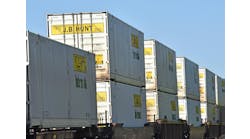Rail traffic increased 2.3% in Week 35 (ended September 3rd), according to Morgan Stanley. An 8% growth in grain volumes and a 6.4% rise in intermodal traffic were partially offset by a 1.9% drop in economically sensitive traffic and a 1.7% decline in coal. Chemical loading fell 2.3% during the week.
“New Orleans is a major interchange, but not an origination point for the railroads,” said Morgan Stanley analyst James Valentine, explaining the minimal initial impact of the storm. CSX, which had the most physical track damage from Katrina, actually reported a modest improvement in average train speed.
Overall, average train speeds for North American Class 1 railroads slowed only 1.8% during the week, an improvement over the four-week trend of a 2.5% drop. For the full 35 weeks of 2005, train speeds are down 3.1%.
Canadian National (CN) posted a 3.4% increase in train speed in the four weeks leading up to September 3rd. Its performance in Week 35 was unchanged. Union Pacific (UP) increased speed 2.3% in the week and 1.1% over the four-week period. Norfolk Southern (NS) had a 1.4% decline in train speed for the week. CSX dropped 2.9% in train speed for the week, Burlington Northern Santa Fe (BNSF) saw a 5% decline, Canadian Pacific (CP) lost 7.4% and Kansas City Southern’s (KCS) train speed was off by 10.3% for the week.


